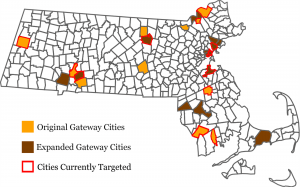Project Overview
Problem
Urban communities suffer from a number of environmental, economic and public health issues. Some of these negative issues include increased levels of air pollution, increased pollution in storm water runoff, and increased levels of energy usage (Akbari, 2005).
There are numerous causes of these various negative impacts within cities, including increased urbanization, industrialization, and aging, inefficient infrastructure. One important cause in many U.S. cities is a decline in tree canopy, which remains a concern in Massachusetts. Many cities have begun exploring how tree planting programs can help to increase tree canopy, in order to reduce the various negative impacts facing urban neighborhoods.
The MA Office of Energy and Environmental Affairs (EEA) has started the Greening the Gateway Cities tree planting program in select Pilot Cities across the state, planting over 5,000 trees so far. The EE A estimates that the program will lower energy use by 10% and save homeowners approximately $230 per year in heating and cooling costs. However, energy savings is only one measure of success of the program. There are also many other measures for the EEA to consider when assessing the success of their tree planting program in the future.
A estimates that the program will lower energy use by 10% and save homeowners approximately $230 per year in heating and cooling costs. However, energy savings is only one measure of success of the program. There are also many other measures for the EEA to consider when assessing the success of their tree planting program in the future.
Goal
The goal of this project was to evaluate the GTGC tree planting program and its impacts on residents and the environment, as well as provide recommendations for future program improvements.


